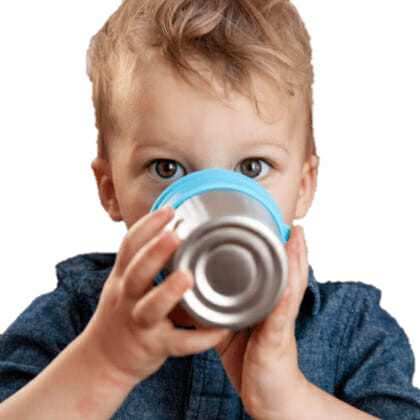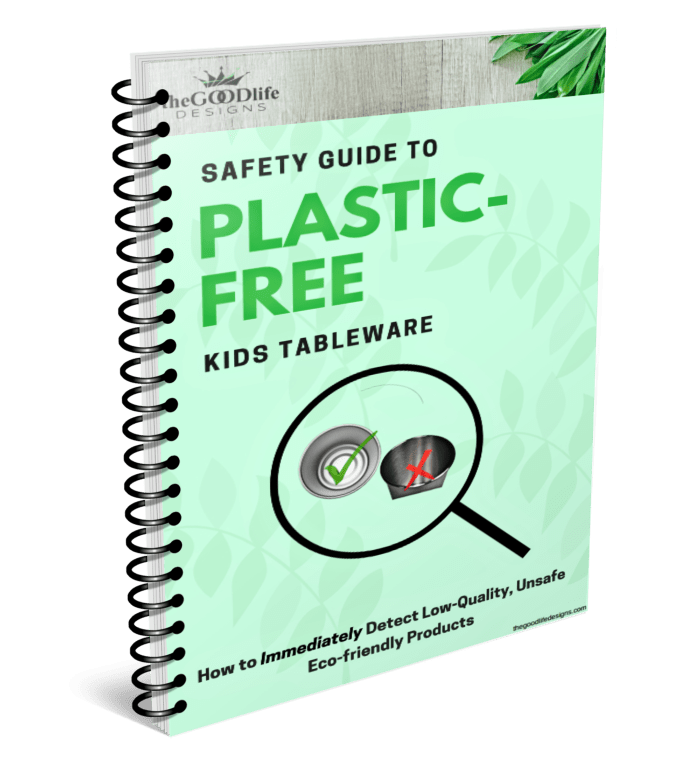
Choosing a cup for your little one can be challenging. Plastic seems easy, but safety and environmental risks are cause for concern.
Enter stainless steel: it’s durable, safe, and eco-friendly, all in one package!
In this guide, I dive into the pros and cons of plastic and stainless steel cups, helping you make the best choice for your child. We’ll explore things like:
- How long do they last?
- Are they safe?
- How much do they cost?
- Are they good for the planet?
- Plus, how to pick the right type of stainless steel to ensure safety.
Ready to ditch the plastic sippies and go eco-chic? With this guide, you can choose the perfect cup that supports your child’s health and the planet!
Key Takeaways: Comparing Plastic Vs. Stainless Steel Kids Cups

Durability: Stainless steel cups are super tough, thanks to a special ingredient called chromium that helps them last longer. Plastic cups, even the strong ones, can’t compete with the lifespan of stainless steel.
Safety and Health Risks: Regarding safety, stainless steel wins hands down. It contains no harmful chemicals (such as BPA), which some plastics have. Even BPA-free plastic cups might release unhealthy chemicals into your child’s drink.
Environmental Impact: Stainless steel is a champion for the planet! It’s 100% recyclable and doesn’t break down into tiny plastic bits that pollute waterways like plastic does. However, making stainless steel uses a lot of energy. Plastic, on the other hand, is a major source of pollution and takes ages to decompose.
Taste: Sometimes, stainless steel cups can give drinks a bit of a metallic taste, especially if the quality isn’t the best (we’ll talk about grades and polishing later). Plastic cups can also affect the taste and smell of drinks, especially with hot liquids. That said, stainless generally works better at keeping flavors pure.
Cost and Variety: Upfront, stainless steel cups might cost more than plastic options. But remember, they last much longer, actually saving you money in the long run. Plastic cups typically cost less and come in various fun shapes and designs.
Pros and Cons of Plastic Drinkware:
Pros:
- Lightweight: Plastic cups weigh less than stainless, making them a breeze for little hands to hold.
- Budget-friendly: Plastic, especially disposable dinnerware options, is super affordable. This makes plastic cups an excellent choice for families on a tight budget.
- Design Variety: Plastic cups come in a rainbow of colors, patterns, and even characters kids love! This can make drinking more fun and encourage them to stay hydrated.
- Shatter-resistant: While some plastics can crack, they won’t shatter into dangerous shards like glass, making them a safer option for young children.
Cons:
- Health Concerns: Certain chemicals in plastic, like BPA and phthalates, can leak into drinks, mainly when used with hot liquids. This raises concerns about potential health risks, especially for children.
- Environmental Impact: Plastic cups are major contributors to pollution in several ways:
- Landfill Fillers: They take up space in landfills and take hundreds of years to break down.
- Harmful to Wildlife: Animals often mistake plastic for food, leading to ingestion, suffocation, and habitat destruction.
- Polluting the Air and Soil: Plastic production and incineration can negatively impact air and soil quality.
- Limited Lifespan: Disposable plastic cups are meant for single use, creating waste. Even reusable plastic cups, though more durable, can crack easily and still contribute to pollution.
- Limited Insulation: Plastic doesn’t insulate well, so drinks lose their desired temperature quickly.
Pros and Cons of Stainless Steel Drinkware:
Pros:
- Safety: Stainless steel is free of harmful chemicals like BPA and phthalates, making it safe for children to drink from, even with hot beverages. Remember to look for 304-grade steel to prevent rust, but we’ll discuss that later.
- Clean and Easy: The smooth, non-porous surface of stainless steel resists bacteria growth, making it hygienic and dishwasher-safe for added convenience.
- Durability: Virtually unbreakable stainless steel is perfect for active kids and clumsy hands. These cups can withstand years of use without breaking, rusting, or staining.
- Sustainability:
- Eco-friendly: Reduces plastic waste by eliminating the need for disposable cups, contributing to a healthier planet.
- Long Lifespan: Can last for decades, preventing countless plastic cups from entering landfills and waterways.
- Infinitely Recyclable: Stainless steel can return to its original form (like drinkware) without losing quality, unlike plastic.
- Partial Insulation: Helps to keep drinks cooler or hotter for longer than plastic.
Cons:
- Higher Initial Cost: Stainless steel cups can be more expensive upfront than plastic, especially disposable options. However, their long lifespan and elimination of replacement costs make them more cost-effective in the long run.
- A Bit Hefty: Stainless steel is naturally heavier than plastic, which might be a consideration for young children with less hand strength.
- **Temperature Transfer: ** Unlike plastic, stainless steel conducts heat and cold more readily. While it offers some insulation, very hot or cold drinks can make the outside of the cup uncomfortable to hold, especially with single-walled cups. Double-walled options help avoid this issue.
- Prone to Dents: Though highly durable, significant drops or impacts can cause dents in stainless steel cups. However, these dents usually affect appearance only, not functionality.
- Limited Design Options: Stainless steel cups typically come in simple metallic finishes or with a limited selection of colors compared to the vast design variety found in plastic.
Summary:
Stainless steel is the clear winner for its durability, safety, and eco-friendliness. It doesn’t leach chemicals, is fully recyclable, and can withstand hot and cold temperatures without breaking down.
On the other hand, while better than single-use, reusable plastic drinkware still has drawbacks. It can leach chemicals, especially with hot liquids, and isn’t as good at keeping drinks at the desired temperature. So stainless steel is the way to go!
Choosing the Right Kind of Stainless Steel (201 vs 304-grade)

Stainless steel sounds great, but there’s a catch: not all types are the same. To get the full benefits, you need the correct grade of steel.
Here’s a quick story to illustrate: When I started in e-commerce (and before I knew better), I sourced a bunch of 201-grade stainless steel cups. Oops. It turns out that while 201-grade is more affordable, it can rust relatively easily. See the above photo.
So, what should you look for? Aim for 304-grade (or 18/8-grade) stainless steel. This grade is much more rust-resistant, meaning your cup won’t turn into an orange surprise if you skip hand-drying.
Shopping online? Here’s a quick tip to check the grade:
- Use the “Find” function (Control+F on PC, Command+F on Mac).
- Type in “201” and see if it pops up in the description. If it does, avoid that cup.
- Repeat the search, but type “304” or “18/8.” If you see these numbers, you’re good to go!
Pro Tip: Look for Electropolished Stainless Steel

One drawback of stainless steel cups is their ability to leave a metallic taste in drinks.
So, look for electropolished stainless steel. This process removes impurities and creates a smoother surface, making the cup:
- Easier to clean: Less chance of bacteria growth.
- Taste-free: No metallic aftertaste in your drinks.
- Extra rust-resistant: Double the protection!
Here are some key takeaways to remember:
- Visually inspect the cup: A smooth, even interior indicates electro-polishing, while a rippled texture suggests the cup lacks this crucial step. See the above photo for comparison.
- Avoid unpolished cups: These are cheaper but susceptible to rusting, leaching, and harboring bacteria.
- Choose reputable brands: Opt for companies that prioritize quality and safety transparency in their products, especially those intended for children.
By following these tips, you can ensure you’re choosing a safe and long-lasting stainless steel cup for your little one (or even yourself!).
FAQs
Is stainless steel safe for my child to drink from?
Yes. High-quality, 304-grade stainless steel is non-toxic, BPA-free, and won’t leach harmful chemicals into your child’s drinks, unlike some plastics. This guarantees a safe and healthy way to keep them hydrated.
Are stainless steel cups durable enough for toddlers?
You bet! Stainless steel is known for being super tough. Unlike glass or plastic options, these cups are practically indestructible, making them perfect for even the clumsiest little hands. They can handle drops, throws, and everyday use without breaking or cracking.
Aren’t stainless steel cups expensive?
The upfront cost might seem higher than plastic cups, but consider them an investment. Stainless steel cups are incredibly durable and can last for years, even decades, with proper care. You won’t have to keep replacing broken drinkware, saving you money in the long run.
Are stainless steel cups eco-friendly?
Absolutely! Since they’re reusable, they eliminate the need for disposable plastic cups, significantly reducing plastic waste. This translates to a healthier planet and a cleaner environment.
What should I look for when buying a stainless steel cup?
Here are some key things to keep in mind:
- Material: Opt for 304-grade (or 18/8-grade) stainless steel for top-notch safety and durability.
- Electro-polishing: Make sure the inside of the cup is electro-polished. This improves hygiene while preventing rust and metallic tastes.
- Size and design: Choose a size and design that suits your child’s age and needs. Consider features like leak-proof lids or straw compatibility for younger children.
The Final Sip: Choosing Between Plastic and Stainless Steel
While plastic and stainless steel each have their pros and cons, the clear winner for health and eco-friendliness is stainless steel.
Let’s review:
- Safety: Stainless steel is the MVP, being non-toxic and free of harmful chemicals, unlike some plastics.
- Durability: Stainless steel cups can last for years, eliminating the need for constant replacements, saving you money, and reducing waste.
- Sustainability: Unlike plastic, which pollutes our planet, stainless steel is 100% recyclable and eco-friendly.
Plastic may be lighter and offer more designs, but these perks are minor compared to the benefits of stainless steel for your child’s health and the environment.
Remember: Choose 304-grade stainless steel and look for electro-polishing for the best quality and safety.
P.S. Looking for more plastic-free options? Check out our Non-Toxic Dinnerware for Kids Guide, featuring our top picks for cups, cutlery, plates, lunchboxes, and more! Or, explore our Lead-Free Dishware Guide to audit your glass and ceramics.

Hi there! I'm Adam, author and founder of TGL. Since 2016, I've produced and sold non-toxic kitchenware throughout the US. Today, I'm using my passion and experience in sustainable product manufacturing to help families avoid unsafe reusable foodware. When I'm not writing, you'll find me hiking or camping throughout Appalachia!
Related Posts
FREE Guide
Safest Non-Toxic Kid’s Tableware Checklist
Discover how to IMMEDIATELY detect subpar kids dinnerware products when browsing online.





